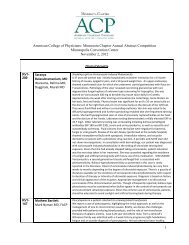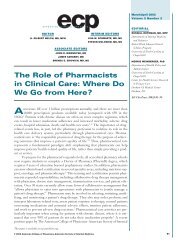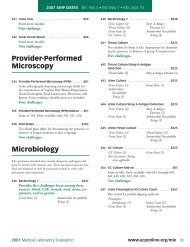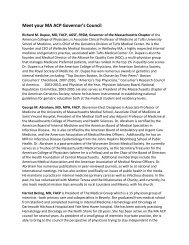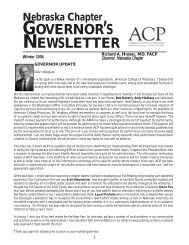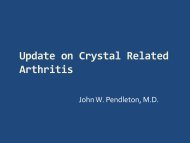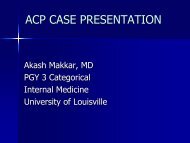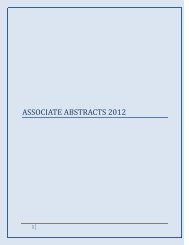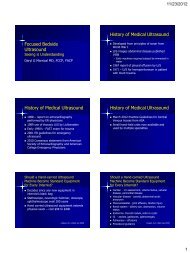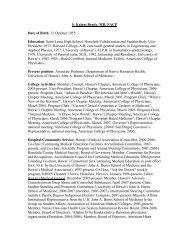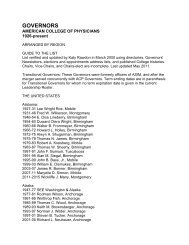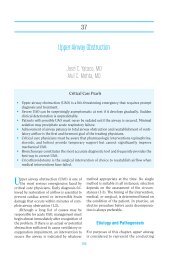Arthrocentesis and Bursal Injection - American College of Physicians
Arthrocentesis and Bursal Injection - American College of Physicians
Arthrocentesis and Bursal Injection - American College of Physicians
You also want an ePaper? Increase the reach of your titles
YUMPU automatically turns print PDFs into web optimized ePapers that Google loves.
<strong>American</strong> <strong>College</strong> <strong>of</strong> <strong>Physicians</strong><br />
Internal Medicine 2011<br />
<strong>Arthrocentesis</strong> <strong>and</strong> <strong>Bursal</strong> <strong>Injection</strong><br />
©2011<strong>American</strong> <strong>College</strong> <strong>of</strong> <strong>Physicians</strong>. All rights reserved. Reproduction <strong>of</strong> Internal Medicine 2011 presentations, or print or electronic material<br />
associated with presentations, is prohibited without written permission from the ACP.
Generic <strong>Arthrocentesis</strong> Procedure<br />
Position the patient in a comfortable position<br />
Usually recumbent, except for upper extremity arthrocentesis - shoulder, elbow,<br />
wrist <strong>and</strong> carpal tunnel injection<br />
Position patient for operator comfort<br />
Identify l<strong>and</strong>marks for needle insertion<br />
Mark site with surgical marking pen or make impression with tip <strong>of</strong> retracted ballpoint<br />
pen<br />
Clean skin at injection site<br />
Clean 3 times with povidone-iodine solution<br />
a) Begin in center <strong>of</strong> area to be cleaned, wiping in widening spirals to periphery<br />
b) Clean area 5 cm in diameter<br />
c) Allow to dry for 1 minute<br />
d) Wipe area <strong>of</strong> needle insertion one time with alcohol sponge<br />
Prepare <strong>and</strong> administer anesthetic<br />
Draw up 3 mL <strong>of</strong> lidocaine in a 3 mL or 5 mL syringe<br />
Using 25-gauge needle, make wheal at the marked injection site<br />
Direct needle towards joint<br />
Inject remainder <strong>of</strong> lidocaine along path to joint capsule<br />
An alternative or an adjunct to injecting lidocaine is ethyl chloride sprayed at the<br />
site <strong>of</strong> needle insertion<br />
Entering joint space<br />
Prepare aspirating syringe with 18 or 20-gauge needle<br />
a) Select syringe size that will be adequate for amount <strong>of</strong> effusion<br />
b) 20 mL syringes commonly used for knee<br />
Pull back on plunger <strong>of</strong> syringe to "break the bead" to ensure smooth <strong>and</strong> easy<br />
operation when in joint<br />
Direct needle through anesthetic wheal toward joint, using firm, confident motion<br />
"Popping" sensation can <strong>of</strong>ten be felt when joint capsule penetrated<br />
Aspirating joint fluid<br />
Stabilize needle with non-dominant h<strong>and</strong><br />
a) Hold hub <strong>of</strong> needle with thumb <strong>and</strong> index finger<br />
b) Rest heel <strong>of</strong> h<strong>and</strong> against patient<br />
Gently aspirate fluid<br />
Ending the procedure<br />
Smoothly withdraw needle <strong>and</strong> syringe as one unit<br />
Apply firm pressure to arthrocentesis/injection site with gauze sponge<br />
Clean <strong>of</strong>f excess povidone-iodine with alcohol<br />
Apply B<strong>and</strong>-Aid to needle insertion site<br />
Option for injecting medication<br />
a) Gently remove syringe with smooth twisting motion<br />
b) Attach syringe with medication
1. Identify the <strong>Injection</strong> Site<br />
<strong>Arthrocentesis</strong> <strong>of</strong> the Knee<br />
Locate superior <strong>and</strong> inferior pole <strong>of</strong> the patella, divide patella in half, <strong>and</strong> locate its<br />
medial border<br />
Mark the injection site, just below medial patellar edge<br />
2. Prepare <strong>Injection</strong> Site<br />
Clean site with povidone-iodine solution.<br />
Wipe with alcohol sponge<br />
3. Inject Local Anesthesia<br />
Spray ethyl chloride over injection site. (optional )<br />
Use 5/8-inch 25-g needle <strong>and</strong> inject sufficient 1% lidocaine to form subcutaneous<br />
wheal<br />
Orient the needle parallel to the undersurface <strong>of</strong> the patella<br />
Insert needle toward the joint injecting 1 to 2-mL <strong>of</strong> lidocaine as needle is withdrawn<br />
4. Remove Synovial Fluid<br />
With non-dominate h<strong>and</strong>, press on the lateral border <strong>of</strong> the patella moving it<br />
medially, this will enhance the joint opening<br />
Introduce a 1-½ inch, 18-g needle attached to adequately sized syringe into the joint<br />
Insert the needle parallel to the undersurface <strong>of</strong> the patella into the joint<br />
Stabilize the syringe/needle complex with the non-dominate h<strong>and</strong> in contact with the<br />
medial aspect <strong>of</strong> the thigh/knee <strong>and</strong> against the syringe<br />
Gently aspirate as much fluid as possible
5. Introduce Steroids (if indicated)<br />
Separate syringe from needle, keeping the needle in the joint<br />
Attach a pre-filled steroid syringe (see “Commonly Used Medicines” chart for<br />
dosage)<br />
Aspirate to determine location <strong>of</strong> needle<br />
If joint position confirmed, gently inject medication<br />
Remove syringe <strong>and</strong> needle, apply firm pressure with gauze<br />
Clean <strong>and</strong> apply b<strong>and</strong>-aid
1. Identify the site<br />
<strong>Arthrocentesis</strong> <strong>of</strong> the Shoulder<br />
Palpate the coracoid process <strong>and</strong> head <strong>of</strong> the humerus<br />
Locate injection site medial to the humerus <strong>and</strong> 1 cm lateral <strong>and</strong> 1 cm inferior to the<br />
coracoid process<br />
Mark the site<br />
2. Prepare injection site<br />
Clean site with povidone-iodine solution<br />
Wipe with alcohol sponge<br />
3. Provide local anesthesia<br />
Spray ethyl chloride over injection site (optional )<br />
Use 5/8-inch 25-g needle <strong>and</strong> inject sufficient 1% lidocaine to form subcutaneous<br />
wheal.<br />
Insert needle toward the joint, posteriorly <strong>and</strong> slightly superiorly <strong>and</strong> laterally,<br />
injecting 1 to 2 mL <strong>of</strong> lidocaine as needle is withdrawn<br />
If bone is hit, withdraw the needle slightly <strong>and</strong> redirect<br />
4. Remove Synovial Fluid<br />
Direct posteriorly <strong>and</strong> upward a 1½ inch, 18-g needle attached to an appropriately<br />
sized syringe<br />
Stabilize the syringe/needle complex with the non-dominate h<strong>and</strong> in contact with the<br />
arm/chest <strong>and</strong> the syringe<br />
Gently aspirate as much fluid as possible
5. Introduce Steroids (if indicated)<br />
Separate syringe from needle, keeping the needle in the joint.<br />
Attach a pre-filled steroid syringe<br />
Aspirate to determine location <strong>of</strong> needle<br />
If joint position is confirmed, gently inject medication<br />
Remove syringe <strong>and</strong> needle, apply firm pressure with gauze<br />
Clean <strong>and</strong> apply B<strong>and</strong>-aid
1. Identify the site<br />
Bicipital Tendon Sheath<br />
With patient seated, position the arm slightly externally rotated, <strong>and</strong> the elbow at the<br />
patient’s side<br />
Palpate the bicipital tendon overlying the anterior capsule <strong>of</strong> the shoulder<br />
The injection site is inferior to the anterior capsule <strong>of</strong> the shoulder<br />
Mark the site<br />
2. Prepare injection site<br />
Clean site with povidone-iodine solution<br />
Wipe with alcohol sponge<br />
3. Provide local anesthesia<br />
Spray ethyl chloride over injection site (optional)<br />
4. Introduce Steroids<br />
Attach a pre-filled 3-5mL lidocaine-steroid-filled syringe to a 1 ½ inch, 25-g needle<br />
Direct needle at a 45° angle upwards in the direction <strong>of</strong> the tendon sheath, using a<br />
“fanning technique” to spread the medication along the tendon sheath<br />
Resistance should not be met when introducing the medication. If resistance is<br />
encountered, reposition the needle to avoid injecting directly into the bicipital tendon<br />
Before each injection, aspirate to ensure the needle is not in a blood vessel<br />
Remove syringe <strong>and</strong> needle, apply firm pressure with gauze<br />
Clean <strong>and</strong> apply b<strong>and</strong>-aid
Subdeltoid (Subacromial) Bursa<br />
1. Identify the site<br />
Palpate the superior surface <strong>of</strong> the shoulder<br />
Move laterally until there is a slight drop-<strong>of</strong>f; this is the lateral edge <strong>of</strong> the acromion<br />
The palpable s<strong>of</strong>t spot below the acromion but above the humeral head is the location<br />
<strong>of</strong> the subdeltoid (subacromial bursa)<br />
Mark the site<br />
2. Prepare injection site<br />
Clean site with povidone-iodine solution<br />
Wipe with alcohol sponge<br />
3. Provide local anesthesia<br />
Spray ethyl chloride over injection site (optional )<br />
4. Introduce Steroids<br />
Attach a pre-filled 3-5 mL lidocaine-steroid-filled syringe to a 1 ½ inch, 25-g needle<br />
Direct the needle perpendicular to the surface through the deltoid muscle <strong>and</strong> into the<br />
bursa. Introduce the needle up to its hub<br />
The needle should be “free-floating” since it is within a space <strong>and</strong> not a muscle or<br />
tendon<br />
Before injection, aspirate to ensure the needle is not in a blood vessel<br />
Gently inject the medication (little resistance should be felt). If resistance is<br />
encountered, reposition the needle to avoid injecting directly into the tendons <strong>of</strong> the<br />
rotator cuff<br />
Remove syringe <strong>and</strong> needle, apply firm pressure with gauze<br />
Clean <strong>and</strong> apply b<strong>and</strong>-aid
1. Identify the site<br />
<strong>Arthrocentesis</strong> <strong>of</strong> the Wrist<br />
Palpate the extensor pollicus longus tendon on the dorsum <strong>of</strong> the wrist as it crosses<br />
the distal radius. This can be easily identified by having the patient lift the thumb<br />
against resistance<br />
The injection site is the shallow depression on the ulnar side <strong>of</strong> the extensor pollicus<br />
longus, just distal to the distal radius<br />
Mark the site<br />
2. Prepare injection site<br />
Clean site with povidone-iodine solution<br />
Wipe with alcohol sponge<br />
3. Provide local anesthesia<br />
Spray ethyl chloride over injection site. (optional)<br />
Use 5/8 inch 25-g needle <strong>and</strong> inject sufficient 1% lidocaine to form subcutaneous<br />
wheal<br />
Insert needle toward the joint injecting 2 mL <strong>of</strong> lidocaine as needle is withdrawn<br />
4. Remove synovial fluid<br />
Flex the joint to 20° to open the joint spaces<br />
With a 1 to 1 ½ inch 20 or 21-gauge needle attached to a 5 or 10 mL syringe, direct<br />
the needle into the joint, perpendicular to the mark. If the needle can be inserted 1.5<br />
to 2 cm, it is correctly positioned in the joint space. The inter-carpal joints have<br />
interconnecting joint spaces, so this dorsal site can be used as a “universal site” for<br />
the wrist<br />
If bone is hit, withdraw the needle slightly <strong>and</strong> redirect slightly toward the thumb<br />
Gently aspirate as much fluid as possible
5. Introduce Steroids (if indicated)<br />
Separate syringe from needle, keeping the needle in the joint.<br />
Attach a pre-filled steroid syringe<br />
Aspirate to determine location <strong>of</strong> needle<br />
If joint position is confirmed, gently inject medication<br />
Remove syringe <strong>and</strong> needle, apply firm pressure with gauze<br />
Clean <strong>and</strong> apply b<strong>and</strong>-aid
1. Identify the site<br />
Carpal Tunnel<br />
Dorsiflex the wrist 30° <strong>and</strong> rest it on a rolled towel or other support<br />
Identify the palmaris longus tendon by having the patient flex the middle finger<br />
against resistance<br />
Mark the site just lateral (ulnar side) <strong>of</strong> the palmaris longus tendon<br />
2. Prepare injection site<br />
Clean site with povidone-iodine solution<br />
Wipe with alcohol sponge<br />
3. Provide local anesthesia<br />
Spray ethyl chloride over injection site (optional )<br />
4. Introduce Steroids<br />
Attach a pre-filled steroid filled 1 or 3 cc syringe to a 5/8 inch, 25-g needle<br />
Angle the needle downward at a 45° angle toward the tip <strong>of</strong> the middle finger.<br />
Insert the needle at the distal wrist crease on the ulnar (lateral) side <strong>of</strong> the palmaris<br />
longus tendon<br />
Insert the needle to its hub<br />
There should be no resistance to injection <strong>and</strong> minimal discomfort. If resistance is<br />
encountered, reposition the needle to avoid injection into the tendon<br />
Remove syringe <strong>and</strong> needle, apply firm pressure with gauze<br />
Clean <strong>and</strong> apply b<strong>and</strong>-aid
1. Identify the site<br />
Greater Trochanteric Bursa<br />
Place the patient in a supine position with the leg in a neutral position<br />
Palpate the greater trochanter as a knob like structure<br />
Rotating the leg internally <strong>and</strong> externally will move the trochanter beneath the fingers<br />
Mark the site<br />
2. Prepare injection site<br />
Clean site with povidone-iodine solution<br />
Wipe with alcohol sponge<br />
3. Provide local anesthesia<br />
Spray ethyl chloride over injection site (optional )<br />
Create a subcutaneous wheal with lidocaine<br />
4. Introduce Steroids<br />
Attach a pre-filled 3 mL steroid-filled syringe to a 1 1/2 inch, 25-g needle<br />
With the leg in a neutral position, apply pressure with the fingers <strong>of</strong> the nondominant<br />
h<strong>and</strong> to compress the overlying tissue<br />
Direct needle directly down to the periosteum using a “fanning technique” to inject<br />
the medication just above the periosteal surface<br />
Remove syringe <strong>and</strong> needle, apply firm pressure with gauze<br />
Clean <strong>and</strong> apply b<strong>and</strong>-aid
Other Joint<br />
<strong>Injection</strong>s
What to do with Synovial Fluid<br />
Direct Observation Comments<br />
Color<br />
Yellow, pink, red or blood Normal synovial fluid is yellow or straw-colored:<br />
occasionally colorless<br />
Turbidity<br />
Clear - newsprint can be read through fluid<br />
Slightly turbid - print is blurry<br />
Turbid - print cannot be seen through fluid<br />
Purulent - fluid is yellowish <strong>and</strong>/or thick<br />
Viscosity<br />
String test can be performed with a drop <strong>of</strong> fluid<br />
between gloved fingers. Note the length <strong>of</strong><br />
“thread” it makes as fingers are separated.<br />
Tests which should not be ordered on joint fluid<br />
Mucin clot Compliment<br />
Total protein Immune complex<br />
Viscosity Red blood count<br />
Rheumatoid factor Glucose<br />
Anti-nuclear antibody<br />
If you have a small sample:<br />
Normal synovial fluid is clear. Turbidity depends<br />
on the presence <strong>of</strong> cells, fibrin, proteinaceous<br />
materials, cellular debris <strong>and</strong> crystals.<br />
Normal synovial fluid forms a 1-3” string. Record<br />
viscosity as normal, decreased, or increased. Note:<br />
Inflammatory fluid typically becomes less viscous<br />
unless grossly purulent.<br />
Place one drop <strong>of</strong> joint fluid on a clean glass slide. Apply cover slip to top <strong>of</strong> the fluid.<br />
Examine under polarized microscopy for crystals. Estimate the number <strong>of</strong> WBCs. The slide<br />
can be separated from cover slip. Gram stain can be performed on the slide for presence <strong>of</strong><br />
bacteria. Wright’s stain can be performed on the cover slip for cell count <strong>and</strong> differential.<br />
Cap the needle <strong>and</strong> send syringe immediately to the microbiology laboratory where the<br />
second drop <strong>of</strong> fluid can be plated for culture or inject remaining fluid in the syringe onto a<br />
sterile swab, place in culturette tube containing a holding media <strong>and</strong> send to laboratory.
Tests to be ordered on joint fluid<br />
Cell count <strong>and</strong><br />
differential:<br />
Use green-top vacutainer (heparin) to prevent clotting <strong>and</strong> to preserve cell<br />
morphology<br />
1. Leukocyte count - Degree <strong>of</strong> leukocyte elevation indicates severity <strong>of</strong><br />
inflammation<br />
Fluid with leukocyte count less than 2000 mm 3 are considered noninflammatory<br />
Fluid with leukocyte count more than 100,000 mm 3 should be<br />
considered infected<br />
Fluid with leukocyte count between 50,000 mm <strong>and</strong> 100,000 mm<br />
may be either infected, due to crystals, or inflammatory<br />
(noninfectious) arthritis<br />
2. Differential leukocyte count - Simply determine the percentage <strong>of</strong><br />
neutrophils <strong>and</strong> monocytes<br />
Non-inflammatory fluid generally has less than 50% neutrophils<br />
Infected fluid generally has more than 95% neutrophils<br />
Non-infectious, inflammatory fluid has more than 50% neutrophils<br />
Microbiology: Culture - aerobic, anaerobic, gram stain <strong>and</strong> if needed AFB <strong>and</strong> fungal.<br />
Use red-top vacutainer (sterile, without additive) if fluid is sent directly to<br />
laboratory<br />
Crystal<br />
Determination:<br />
Wet prep<br />
1. Examine a drop <strong>of</strong> synovial fluid under a coverslip by routine<br />
microscopy. Crystals can <strong>of</strong>ten be seen without a polarizing light<br />
microscope<br />
Urate crystals (gout) are needle-like, or blunt rods<br />
Calcium pyrophosphate crystals (psuedogout) may be blunt rods or<br />
rhomboids<br />
2. Proper polarized light microscopy requires both a high quality, wellmaintained<br />
microscope <strong>and</strong> an experienced observer
Search For Crystals: How To Do It<br />
♦ Take a clean slide <strong>and</strong> place a drop <strong>of</strong> synovial fluid from<br />
red top tube on a slide <strong>and</strong> cover with a clean cover slip.<br />
♦ Study the cells under 100X <strong>and</strong> 400X magnification. Look<br />
for crystals <strong>of</strong> any size or shape.<br />
♦ Polarize the microscope by turning the polarizer beneath<br />
the stage, Make the field become entirely "black" (this is<br />
when polarizer <strong>and</strong> analyzer are at 900 phase). The<br />
birefringent objects will appear bright. Gradually turn the<br />
polarizer to add a slight bit <strong>of</strong> light for orientation<br />
purposes. Monosodium urate crystals (MSU) will<br />
typically appear needle-shaped. Calcium pyrophosphate<br />
dihydrate crystals (CPPQ) will appear more pleomorphic<br />
:with rods, <strong>of</strong>ten square-ended <strong>and</strong> parallel in clumps,<br />
which appear less bright.<br />
♦ Positive identification <strong>of</strong> crystals with the use <strong>of</strong><br />
first-order red compensator. Note the axis <strong>of</strong> the<br />
compensator lens, crystals which are parallel to the axis<br />
<strong>of</strong> the lens which appear yellow, are considered to be<br />
negatively birefringent. Conversely, crystals which are<br />
parallel to the compensator <strong>and</strong> appear blue are<br />
considered to be positively birefringent.<br />
♦ Hint: YUP (yellow urate parallel) monosodium urate<br />
crystals, when parallel to the first-order red compensator,<br />
will be yellow <strong>and</strong> are considered to be positively<br />
birefringent.
Commonly Used Medication Dosages for Joint <strong>and</strong> S<strong>of</strong>t Tissue <strong>Injection</strong><br />
Procedure<br />
Triamcinalone<br />
acetonide (Kenalog)<br />
or hexacetonide<br />
(Aristospan)<br />
<strong>Arthrocentesis</strong><br />
Knee 40 mg<br />
Shoulder 40 mg<br />
Elbow 20 mg<br />
Ankle 20-30 mg<br />
Wrist 20 mg 20 mg<br />
CMC/MCP/PIP 5-10 mg<br />
Acromioclavicular 5-10 mg<br />
Sternoclavicular 5-10 mg<br />
Methylprednisolone<br />
acetate<br />
(Depomedrol)<br />
<strong>Bursal</strong><br />
Subdeltoid 40 mg 2 mL<br />
Greater Trochanter 40 mg 2 mL<br />
Anserine 10 mg 2 mL<br />
Tendinitis Sites<br />
Bicipital tendon sheath 20 mg 20 mg 2 mL<br />
Lateral/medial epicondyle 10 mg 10mg 1 mL<br />
Trigger Point<br />
Intramuscular 5 mg 5mg 2 mL<br />
Miscellaneous Sites<br />
Carpal tunnel 10-20 mg<br />
Tarsal tunnel 10-20 mg 10-20 mg<br />
Costochondral junction 5mg 5 mg 1 mL<br />
Lidocaine 1%
Supplies <strong>and</strong> Equipment<br />
Preparatory Materials<br />
Povidone-iodine (Betadine)<br />
Isopropyl alcohol (or individually packaged alcohol wipes)<br />
4 x 4 sterile gauze sponges<br />
Latex gloves (vinyl if you or the patient has a latex sensitivity)<br />
Surgical absorbent pad (the blue "Chux" pad)<br />
Ethyl chloride spray (optional)<br />
Hemostat<br />
For Local Anesthesia<br />
20-gauge, 1 inch or 1 1/2 inch needle<br />
25-gauge, 5/8 inch or 1 1/2 inch needle<br />
3 or 5 mL syringe<br />
1% lidocaine hydrochloride<br />
For <strong>Arthrocentesis</strong><br />
18-gauge or 20-gauge needle<br />
20 - 50 mL syringe, depending upon size <strong>of</strong> effusion<br />
For <strong>Bursal</strong> <strong>Injection</strong>s or Tendon Sheath injections<br />
25-gauge 1 ½ inch needle<br />
3-5 mL syringes<br />
For Arthrocenteses <strong>and</strong> <strong>Bursal</strong> injections<br />
Triamcinalone acetonide (Kenalog) or hexacetonide (Aristospan), or<br />
methylprednisone acetate (Depo-Medrol), see table on glucocorticoids: Intra-<br />
Articular <strong>Injection</strong>s<br />
3-5 mL syringes<br />
For Joint Fluid Analysis<br />
Red top tubes (no additives)<br />
1 for culture<br />
1 for crystal determination<br />
Green top tubes (sodium heparin) for cell count/differential<br />
Gray top tube (sodium fluoride) for glucose test (not routinely indicated)<br />
Finishing up<br />
B<strong>and</strong>-Aid<br />
Microbiology <strong>and</strong> cytology request forms<br />
OSHA approved sharps container<br />
Red plastic bag for contaminated materials<br />
To improve efficiency, physicians may find it useful to make up an<br />
arthrocentesis tray for the <strong>of</strong>fice.
Lost the needle insertion l<strong>and</strong>mark<br />
Problems <strong>and</strong> Pitfalls<br />
Mark site <strong>of</strong> insertion with surgical pen<br />
Use thumb <strong>and</strong> finger <strong>of</strong> non-dominant h<strong>and</strong> to "frame" injection site after it has<br />
been marked<br />
Needle strikes bone<br />
Withdraw needle away from bone<br />
Redirect needle beneath surface <strong>of</strong> skin <strong>and</strong> insert<br />
Needle is in joint, but fluid is difficult to aspirate<br />
Fluid may be too viscous for needle<br />
Try with larger size gauge; 18-gauge<br />
Fluid stops flowing<br />
Tissue may be obstructing needle as joint volume decreases<br />
Try to reposition needle slightly<br />
If needle appears to be obstructed, re-inject a small volume <strong>of</strong> fluid, then aspirate<br />
again<br />
Sitting patient appears pale, diaphoretic or complains <strong>of</strong> being faint<br />
Stop procedure<br />
Immediately lay patient in supine position<br />
Support legs with table extension
Coding Guidelines<br />
Code Description Diagnosis<br />
20600 <strong>Arthrocentesis</strong>, aspiration, <strong>and</strong>/or 727.05 teno/synovitis-h<strong>and</strong>s/fingers<br />
injection; small joint bursa (fingers, toes) 727.06 teno/synovitis-foot/toes<br />
20605 <strong>Arthrocentesis</strong>, aspiration <strong>and</strong>/or<br />
727.05 teno/synovitis-wrist<br />
injection; intermediate joint or bursa<br />
(TMJ, AC joints, wrist, elbow, ankle or<br />
olecranon bursa)<br />
727.09 teno/synovitis-olecranon bursa, anserine<br />
bursa<br />
727.06 teno/synovitis-ankle<br />
20610 <strong>Arthrocentesis</strong>, aspiration <strong>and</strong>/or<br />
719.26 synovitis, knee<br />
injection; large joint or bursa (knee,<br />
subacromial bursa)<br />
719.06 effusion, knee<br />
726.10 bursitis, shoulder<br />
726.5 bursitis, hip<br />
20550 <strong>Injection</strong>(s), single tendon sheath,<br />
ligament, aponeurosis<br />
726.0 synovitis, shoulder<br />
See appendix A for acceptable codes for<br />
injection(s), single tendon sheath, ligament,<br />
aponeurosis<br />
20551 <strong>Injection</strong>(s), single tendon origin/insertion See appendix A for acceptable codes for<br />
injection(s), single tendon origin/insertion<br />
20552 <strong>Injection</strong>, trigger point(s) - single or<br />
The only covered diagnoses are:<br />
multiple, one or two muscles<br />
729.0 Rheumatism, unspecified <strong>and</strong> fibrositis<br />
May be used only once per visit<br />
729.1 Myalgia <strong>and</strong> myositis, unspecified<br />
(Fibromyositis)<br />
729.4 Fasciitis, unspecified<br />
20553 <strong>Injection</strong>, trigger point(s) - single or<br />
The only covered diagnoses are:<br />
multiple, three or more muscles<br />
729.0 Rheumatism, unspecified <strong>and</strong> fibrositis<br />
May be used only once per visit<br />
729.1 Myalgia <strong>and</strong> myositis, unspecified<br />
(Fibromyositis)<br />
729.4 Fasciitis, unspecified<br />
20612 Aspiration <strong>and</strong>/or injection <strong>of</strong> ganglion<br />
cyst(s) any location<br />
See appendix A for acceptable codes for<br />
aspiration <strong>and</strong>/or injection <strong>of</strong> ganglion cyst(s) any<br />
location<br />
FOR VISCOPROTECTIVE TX<br />
J7321 Hyalgan, 20mg or Supartz 25mg 715.16 osteoarthritis <strong>of</strong> knee<br />
J7322 Synvisc, 2ml 715.16 osteoarthritis <strong>of</strong> knee<br />
J7323 Euflexxa 2ml 715.16 osteoarthritis <strong>of</strong> knee<br />
J7324 Orthorvisc 2ml 715.16 osteoarthritis <strong>of</strong> knee<br />
Appendix A<br />
Tendon Sheath <strong>Injection</strong> Codes<br />
Codes that are acceptable with 20550 thru 20551 <strong>and</strong> 20612
ICD-9 Codes that Support Medical Necessity<br />
Note: Diagnosis codes are based on the current ICD-9-CM codes that are effective at the<br />
time <strong>of</strong> LCD publication. Any updates to ICD-9-CM codes will be reviewed by NAS; <strong>and</strong><br />
coverage should not be presumed until the results <strong>of</strong> such review have been<br />
published/posted.<br />
These are the only covered ICD-9-CM codes that support medical necessity:<br />
354.0 CARPAL TUNNEL SYNDROME<br />
355.5 TARSAL TUNNEL SYNDROME<br />
355.6* LESION OF PLANTAR NERVE<br />
720.0 ANKYLOSING SPONDYLITIS<br />
720.1 SPINAL ENTHESOPATHY<br />
720.2 SACROILIITIS NOT ELSEWHERE CLASSIFIED<br />
720.81 INFLAMMATORY SPONDYLOPATHIES IN DISEASES CLASSIFIED ELSEWHERE<br />
720.89 OTHER INFLAMMATORY SPONDYLOPATHIES<br />
720.9 UNSPECIFIED INFLAMMATORY SPONDYLOPATHY<br />
723.7 OSSIFICATION OF POSTERIOR LONGITUDINAL LIGAMENT IN CERVICAL REGION<br />
724.71 HYPERMOBILITY OF COCCYX<br />
724.79 OTHER DISORDERS OF COCCYX<br />
726.0 ADHESIVE CAPSULITIS OF SHOULDER<br />
726.10 DISORDERS OF BURSAE AND TENDONS IN SHOULDER REGION UNSPECIFIED<br />
726.11 CALCIFYING TENDINITIS OF SHOULDER<br />
726.12 BICIPITAL TENOSYNOVITIS<br />
726.19 OTHER SPECIFIED DISORDERS OF BURSAE AND TENDONS IN SHOULDER REGION<br />
726.2 OTHER AFFECTIONS OF SHOULDER REGION NOT ELSEWHERE CLASSIFIED<br />
726.30 ENTHESOPATHY OF ELBOW UNSPECIFIED<br />
726.31 MEDIAL EPICONDYLITIS<br />
726.32 LATERAL EPICONDYLITIS<br />
726.33 OLECRANON BURSITIS<br />
726.39 OTHER ENTHESOPATHY OF ELBOW REGION<br />
726.4 ENTHESOPATHY OF WRIST AND CARPUS<br />
726.5 ENTHESOPATHY OF HIP REGION<br />
726.60 ENTHESOPATHY OF KNEE UNSPECIFIED<br />
726.61 PES ANSERINUS TENDINITIS OR BURSITIS<br />
726.62 TIBIAL COLLATERAL LIGAMENT BURSITIS
726.63 FIBULAR COLLATERAL LIGAMENT BURSITIS<br />
726.64 PATELLAR TENDINITIS<br />
726.65 PREPATELLAR BURSITIS<br />
726.69 OTHER ENTHESOPATHY OF KNEE<br />
726.70 ENTHESOPATHY OF ANKLE AND TARSUS UNSPECIFIED<br />
726.71 ACHILLES BURSITIS OR TENDINITIS<br />
726.72 TIBIALIS TENDINITIS<br />
726.73 CALCANEAL SPUR<br />
726.79 OTHER ENTHESOPATHY OF ANKLE AND TARSUS<br />
726.8 OTHER PERIPHERAL ENTHESOPATHIES<br />
726.90 ENTHESOPATHY OF UNSPECIFIED SITE<br />
726.91 EXOSTOSIS OF UNSPECIFIED SITE<br />
727.00 SYNOVITIS AND TENOSYNOVITIS UNSPECIFIED<br />
727.01 SYNOVITIS AND TENOSYNOVITIS IN DISEASES CLASSIFIED ELSEWHERE<br />
727.02 GIANT CELL TUMOR OF TENDON SHEATH<br />
727.03 TRIGGER FINGER (ACQUIRED)<br />
727.04 RADIAL STYLOID TENOSYNOVITIS<br />
727.05 OTHER TENOSYNOVITIS OF HAND AND WRIST<br />
727.06 TENOSYNOVITIS OF FOOT AND ANKLE<br />
727.09 OTHER SYNOVITIS AND TENOSYNOVITIS<br />
727.1 BUNION<br />
727.2 SPECIFIC BURSITIDES OFTEN OF OCCUPATIONAL ORIGIN<br />
727.3 OTHER BURSITIS DISORDERS<br />
727.40 SYNOVIAL CYST UNSPECIFIED<br />
727.41 GANGLION OF JOINT<br />
727.42 GANGLION OF TENDON SHEATH<br />
727.43 GANGLION UNSPECIFIED<br />
727.49 OTHER GANGLION AND CYST OF SYNOVIUM TENDON AND BURSA<br />
727.50 RUPTURE OF SYNOVIUM UNSPECIFIED<br />
727.51 SYNOVIAL CYST OF POPLITEAL SPACE<br />
727.59 OTHER RUPTURE OF SYNOVIUM<br />
727.60 NONTRAUMATIC RUPTURE OF UNSPECIFIED TENDON<br />
727.61 COMPLETE RUPTURE OF ROTATOR CUFF
727.62 NONTRAUMATIC RUPTURE OF TENDONS OF BICEPS (LONG HEAD)<br />
727.63 NONTRAUMATIC RUPTURE OF EXTENSOR TENDONS OF HAND AND WRIST<br />
727.64 NONTRAUMATIC RUPTURE OF FLEXOR TENDONS OF HAND AND WRIST<br />
727.65 NONTRAUMATIC RUPTURE OF QUADRICEPS TENDON<br />
727.66 NONTRAUMATIC RUPTURE OF PATELLAR TENDON<br />
727.67 NONTRAUMATIC RUPTURE OF ACHILLES TENDON<br />
727.68 NONTRAUMATIC RUPTURE OF OTHER TENDONS OF FOOT AND ANKLE<br />
727.69 NONTRAUMATIC RUPTURE OF OTHER TENDON<br />
727.81 CONTRACTURE OF TENDON (SHEATH)<br />
727.82 CALCIUM DEPOSITS IN TENDON AND BURSA<br />
727.83 PLICA SYNDROME<br />
727.89 OTHER DISORDERS OF SYNOVIUM TENDON AND BURSA<br />
727.9 UNSPECIFIED DISORDER OF SYNOVIUM TENDON AND BURSA<br />
728.4 LAXITY OF LIGAMENT<br />
728.5 HYPERMOBILITY SYNDROME<br />
728.6 CONTRACTURE OF PALMAR FASCIA<br />
728.71 PLANTAR FASCIAL FIBROMATOSIS<br />
728.79 OTHER FIBROMATOSES OF MUSCLE LIGAMENT AND FASCIA<br />
729.0 RHEUMATISM UNSPECIFIED AND FIBROSITIS<br />
729.1 MYALGIA AND MYOSITIS UNSPECIFIED<br />
729.4 FASCIITIS UNSPECIFIED<br />
733.6 TIETZE'S DISEASE<br />
840.0 ACROMIOCLAVICULAR (JOINT) (LIGAMENT) SPRAIN<br />
840.1 CORACOCLAVICULAR (LIGAMENT) SPRAIN<br />
840.2 CORACOHUMERAL (LIGAMENT) SPRAIN<br />
840.3 INFRASPINATUS (MUSCLE) (TENDON) SPRAIN<br />
840.4 ROTATOR CUFF (CAPSULE) SPRAIN<br />
840.5 SUBSCAPULARIS (MUSCLE) SPRAIN<br />
840.6 SUPRASPINATUS (MUSCLE) (TENDON) SPRAIN<br />
840.7 SUPERIOR GLENOID LABRUM LESION<br />
840.8 SPRAIN OF OTHER SPECIFIED SITES OF SHOULDER AND UPPER ARM<br />
840.9 SPRAIN OF UNSPECIFIED SITE OF SHOULDER AND UPPER ARM<br />
841.0 RADIAL COLLATERAL LIGAMENT SPRAIN
841.1 ULNAR COLLATERAL LIGAMENT SPRAIN<br />
841.2 RADIOHUMERAL (JOINT) SPRAIN<br />
841.3 ULNOHUMERAL (JOINT) SPRAIN<br />
841.8 SPRAIN OF OTHER SPECIFIED SITES OF ELBOW AND FOREARM<br />
841.9 SPRAIN OF UNSPECIFIED SITE OF ELBOW AND FOREARM<br />
842.00 SPRAIN OF UNSPECIFIED SITE OF WRIST<br />
842.01 SPRAIN OF CARPAL (JOINT) OF WRIST<br />
842.02 SPRAIN OF RADIOCARPAL (JOINT) (LIGAMENT) OF WRIST<br />
842.09 OTHER WRIST SPRAIN<br />
842.10 SPRAIN OF UNSPECIFIED SITE OF HAND<br />
842.11 SPRAIN OF CARPOMETACARPAL (JOINT) OF HAND<br />
842.12 SPRAIN OF METACARPOPHALANGEAL (JOINT) OF HAND<br />
842.13 SPRAIN OF INTERPHALANGEAL (JOINT) OF HAND<br />
842.19 OTHER HAND SPRAIN<br />
843.0 ILIOFEMORAL (LIGAMENT) SPRAIN<br />
843.1 ISCHIOCAPSULAR (LIGAMENT) SPRAIN<br />
843.8 SPRAIN OF OTHER SPECIFIED SITES OF HIP AND THIGH<br />
843.9 SPRAIN OF UNSPECIFIED SITE OF HIP AND THIGH<br />
844.0 SPRAIN OF LATERAL COLLATERAL LIGAMENT OF KNEE<br />
844.1 SPRAIN OF MEDIAL COLLATERAL LIGAMENT OF KNEE<br />
844.2 SPRAIN OF CRUCIATE LIGAMENT OF KNEE<br />
844.3 SPRAIN OF TIBIOFIBULAR (JOINT) (LIGAMENT) SUPERIOR OF KNEE<br />
844.8 SPRAIN OF OTHER SPECIFIED SITES OF KNEE AND LEG<br />
844.9 SPRAIN OF UNSPECIFIED SITE OF KNEE AND LEG<br />
845.00 UNSPECIFIED SITE OF ANKLE SPRAIN<br />
845.01 DELTOID (LIGAMENT) ANKLE SPRAIN<br />
845.02 CALCANEOFIBULAR (LIGAMENT) ANKLE SPRAIN<br />
845.03 TIBIOFIBULAR (LIGAMENT) SPRAIN DISTAL<br />
845.09 OTHER ANKLE SPRAIN<br />
845.10 UNSPECIFIED SITE OF FOOT SPRAIN<br />
845.11 TARSOMETATARSAL (JOINT) (LIGAMENT) SPRAIN<br />
845.12 METATARSAOPHALANGEAL (JOINT) SPRAIN<br />
845.13 INTERPHALANGEAL (JOINT) TOE SPRAIN
845.19 OTHER FOOT SPRAIN<br />
846.0 LUMBOSACRAL (JOINT) (LIGAMENT) SPRAIN<br />
846.1 SACROILIAC (LIGAMENT) SPRAIN<br />
846.2 SACROSPINATUS (LIGAMENT) SPRAIN<br />
846.3 SACROTUBEROUS (LIGAMENT) SPRAIN<br />
846.8 OTHER SPECIFIED SITES OF SACROILIAC REGION SPRAIN<br />
846.9 UNSPECIFIED SITE OF SACROILIAC REGION SPRAIN<br />
847.0 NECK SPRAIN<br />
847.1 THORACIC SPRAIN<br />
847.2 LUMBAR SPRAIN<br />
847.3 SPRAIN OF SACRUM<br />
847.4 SPRAIN OF COCCYX<br />
847.9 SPRAIN OF UNSPECIFIED SITE OF BACK<br />
848.0 SPRAIN OF SEPTAL CARTILAGE OF NOSE<br />
848.1 JAW SPRAIN<br />
848.2 THYROID REGION SPRAIN<br />
848.3 SPRAIN OF RIBS<br />
848.40 STERNUM SPRAIN UNSPECIFIED PART<br />
848.41 STERNOCLAVICULAR (JOINT) (LIGAMENT) SPRAIN<br />
848.42 CHONDROSTERNAL (JOINT) SPRAIN<br />
848.49 OTHER SPRAIN OF STERNUM<br />
848.5 PELVIC SPRAIN<br />
848.8 OTHER SPECIFIED SITES OF SPRAINS AND STRAINS<br />
848.9 UNSPECIFIED SITE OF SPRAIN AND STRAIN<br />
*Use 355.6 for Morton's metatarsalgia, neuralgia, or neuroma<br />
http://www.noridianmedicare.com/provider/pubs/med_b/policy/final/11state/B2002_16.html
Comments<br />
If an EM visit is to be billed in conjunction with a procedure such as a joint aspiration<br />
or bursal injection, separate <strong>and</strong> different diagnosis codes must be used for the visit<br />
<strong>and</strong> the procedure (Modifier 25 for the visit code must be used on the EM visit)<br />
If an arthrocentesis is performed bilaterally, bill only one arthrocentesis procedure<br />
code <strong>and</strong> add modifer –50 in the injection code (Bilateral knees 20610-50)<br />
Most insurance companies will not pay for a joint injection <strong>and</strong> a trigger point<br />
injection together. You must decide which one to bill<br />
Modifier 59<br />
Add a –59 modifier for each additional arthrocentesis procedure for separate ( non<br />
bilateral site)<br />
For multiple joint procedures, payments will be reduced as follows:<br />
2 nd at 50%<br />
3 rd at 25%<br />
20550 <strong>and</strong> 20551 Use only once if multiple injections into one site, but may be<br />
used multiple times if multiple sites injected – use modifier 59<br />
20552 <strong>and</strong> 20553 Trigger point injections - can only be used one time per visit in<br />
spite <strong>of</strong> the number <strong>of</strong> sites injects . 20552 reflects one or two muscle injections <strong>and</strong><br />
20553 reflects three or more injections.<br />
Don’t forget to bill for:<br />
triamcinolone 10 mg/unit (J3301)<br />
methylprednisolone 20 mg/unit (J1020)<br />
General Information<br />
Documentation Requirements<br />
The clinical record should include the elements leading to the diagnosis <strong>and</strong> the therapies tried<br />
before the decision to use injection. If the number <strong>of</strong> injections exceeds three, the record must<br />
justify these added injections since the presumed need for further injections should raise the<br />
issues <strong>of</strong> correct diagnosis or correct choice <strong>of</strong> therapy as well as concerns for adverse side<br />
effects. Records must be made available upon request.<br />
Submission <strong>of</strong> joint space injection codes (20600, 20605, 20610) in addition to tendon<br />
sheath/origin injections (20550 <strong>and</strong>/or 20551) must be supported by documentation in the<br />
medical record <strong>of</strong> the medical necessity <strong>of</strong> separate procedures.
Primary Care Approach to Rheumatology<br />
An Outline <strong>of</strong> the Important Elements to Elicit in a History <strong>and</strong> Physical Examination<br />
Clinical goals <strong>of</strong> rheumatological history <strong>and</strong> physical examination are to determine if the<br />
process is:<br />
Articular or nonarticular<br />
Acute or chronic<br />
Monoarticular or polyarticular<br />
Inflammatory or noninflammatory<br />
Axial or peripheral<br />
Symmetrical or asymmetrical<br />
Limited musculoskeletal process or systemic process<br />
Elements to Elicit in a History<br />
Demographics Age, sex <strong>and</strong> race are important.<br />
Systemic rheumatic diseases usually begin in young <strong>and</strong> middle-aged<br />
women<br />
Gout is infrequent in premenopausal women<br />
Temporal arteritis is uncommon in blacks, SLE (systemic lupus<br />
erythematosus) more frequent<br />
Social<br />
considerations<br />
Occupation <strong>and</strong> relation <strong>of</strong> work to symptoms<br />
Workman's compensation claim or lawsuit<br />
Pattern <strong>of</strong> pain Determine if pain is:<br />
Localized to joints or surrounding tissue<br />
Generalized or localized to a single joint or area<br />
Intermittent, acute, episodic or migratory <strong>and</strong> additive<br />
Description <strong>of</strong> pain Muscle <strong>and</strong> joint pain may be "cramping" or "throbbing"<br />
Neuropathic pain may be "burning" or "tingling"<br />
Stiffness <strong>and</strong><br />
fatigue<br />
General symptoms<br />
are a clue to<br />
underlying disease<br />
process<br />
Helps differentiate inflammatory from noninflammatory conditions<br />
Greater than 1 hour suggests inflammatory conditions<br />
Early onset <strong>of</strong> fatigue suggests inflammatory condition<br />
SLE <strong>and</strong> other connective tissue diseases<br />
Neurological symptoms, mucocutaneous lesions, photosensitivity, dry<br />
eyes <strong>and</strong> mouth, pleuritis, Raynaud's phenomenon<br />
Gout<br />
Renal stones<br />
Reiter's syndrome, Behcet's disease, acute gonococcal arthritis<br />
Genital ulcerations, penile or vaginal discharge<br />
Malignancy or infection<br />
Fever, weight loss, anorexia
Physical Examination<br />
The focus <strong>of</strong> examination is the musculoskeletal system, but a general physical<br />
examination can reveal helpful clues to diagnosis<br />
Scalp, Skin, Nails<br />
<strong>and</strong> Hair:<br />
Eyes <strong>and</strong> Mouth:<br />
Pulmonary:<br />
Nervous System:<br />
Genitalia:<br />
Symptoms Causes<br />
Alopecia, discoid lupus, psoriasis Connective tissue disease<br />
Psoriatic arthritis<br />
Tender temporal artery Temporal arteritis<br />
Malar rash, or sun-exposure rash Connective tissue disease<br />
Psoriasis over elbows, knees, pitting<br />
<strong>of</strong> nails<br />
Psoriatic arthritis<br />
Periorbital or dorsal h<strong>and</strong> rash Dermatomyositis<br />
Generalized tightening <strong>of</strong> skin over<br />
h<strong>and</strong>s, proximal limbs, trunk<br />
Enlarging macular or papular rash with<br />
central clearing<br />
Scleroderma<br />
Lyme disease<br />
Dryness <strong>of</strong> eyes <strong>and</strong> mouth Sjogren's syndrome<br />
Changes in ocular fundi Connective tissue disease or vasculitis<br />
Iritis or uveitis HLA-B27 related disease<br />
Oral ulcerations Connective tissue disease or Reiter's,<br />
Behcet's disease<br />
Interstitial fibrosis Scleroderma<br />
Pleuritis Cnnective tissue disease<br />
Peripheral nervous system findings Mononeuritis multiplex (i.e: foot drop)<br />
Vasculitis<br />
Central nervous system findings Connective tissue disease, vasculitis<br />
or scleroderma<br />
Ulcers or discharge Reiter's, Behcet's, or gonococcal<br />
infection<br />
General Physical Examination Findings <strong>of</strong> the Joints<br />
Observe <strong>and</strong> palpate for swelling, warmth, tenderness, crepitus<br />
Assess range <strong>of</strong> motion, passive <strong>and</strong> active<br />
Assess deformity such as ligamentous destruction, contracture, bony enlargement or<br />
subluxation
The Spine<br />
1. Cervical Spine<br />
2. Thoracic spine<br />
3. Lumbar spine<br />
4. Sacroiliac joints<br />
The Shoulder<br />
Specific Joint Examination Checklist<br />
Inspect for normal cervical lordosis<br />
Range <strong>of</strong> motion<br />
45 ° flexion<br />
50° - 60° extension<br />
60° - 80° rotation<br />
40° lateral flexion<br />
Inspect for normal thoracic kyphosis<br />
Range <strong>of</strong> motion<br />
Assess by rotation <strong>of</strong> shoulders with hips stabilized<br />
Chest expansion at least 2 inches from full inspiration to full expiration<br />
Inspect for normal lordosis<br />
Range <strong>of</strong> motion<br />
Forward flexion - assessed by Wright-Schober test<br />
(A line measured 10 cm above to 5 cm below the iliac crest will normally<br />
lengthen 4 cm to 8 cm with forward flexion)<br />
Test for tenderness by palpation<br />
Direct pressure over the sacrum<br />
Compression <strong>of</strong> the anterior iliac crest<br />
Palpate for tenderness<br />
Assess symmetry between shoulders<br />
Lateral aspect <strong>of</strong> humeral head<br />
Rotator cuff tendinitis<br />
Anterior humeral groove<br />
Biceps tendinitis<br />
Acromioclavicular joint<br />
Sternoclavicular joint<br />
Range <strong>of</strong> Motion<br />
Raise arms above head in a wide sideways arc
The Elbow<br />
Raise arms in a forward arc, touch palms above head<br />
Touch top <strong>of</strong> head with elbows flexed<br />
Reaching back to touch midback area<br />
If able to perform, suggests normal glenohumeral joint motion <strong>and</strong> intact rotator<br />
cuff<br />
If unable to perform, do drop test for rotator cuff tear (patient unable to hold arm<br />
in the horizontal plane without support)<br />
Palpate for tenderness <strong>and</strong> swelling<br />
Fullness in the area between the lateral epicondyle, radial head, <strong>and</strong> olecranon<br />
indicates joint effusion<br />
Swelling directly over olecranon process indicates bursitis<br />
Rheumatoid nodules may be found over the olecranon area <strong>and</strong> distal ulnar shaft<br />
Range <strong>of</strong> motion<br />
Extension on the horizontal plane to 150° - 160°<br />
Wrist <strong>and</strong> H<strong>and</strong><br />
Palpate for tenderness <strong>and</strong> swelling<br />
Ulnar styloid for swelling <strong>and</strong> instability<br />
Cystic swelling over the dorsal aspect <strong>of</strong> h<strong>and</strong><br />
Ganglion cyst or tenosynovitis<br />
Flexor tendon sheaths, palmar fascia<br />
Nodules or thickening (trigger finger)<br />
Dupuytren's contractures<br />
Range <strong>of</strong> motion<br />
Flexion to 90°<br />
Extension to 70°<br />
Joints <strong>of</strong> the h<strong>and</strong> - Observe <strong>and</strong> palpate for tenderness, swelling <strong>and</strong> loss <strong>of</strong> movement<br />
Metacarpophalangeal joints<br />
Involved in rheumatoid arthritis<br />
Proximal interphalangeal joints<br />
Involved in both osteoarthritis <strong>and</strong> rheumatoid arthritis<br />
Bony swelling referred to as Bouchard's nodes<br />
Distal interphalangeal joints<br />
Involved in osteoarthritis <strong>and</strong> psoriatic arthritis<br />
Bony swelling referred to as Heberden's nodes<br />
Grip strength<br />
Can be objectively measured grasping partially inflated blood pressure cuff
The Hip<br />
Nail abnormalities<br />
Psoriasis, Reiter's syndrome<br />
Localization <strong>of</strong> hip pain<br />
Anterior hip pain<br />
True acetabular disease<br />
Lateral <strong>and</strong> posterior<br />
Wide variety <strong>of</strong> periarticular problems<br />
Range <strong>of</strong> motion (patient supine)<br />
Flex knee <strong>and</strong> hip, then abduct laterally<br />
Tenderness around lateral hip suggests trochanteric bursitis<br />
Deep buttock tenderness suggests ischiogluteal bursitis<br />
Tenderness in the anterior thigh or groin suggests hip joint pain or iliopectineal<br />
bursitis<br />
The Knee<br />
Inspect <strong>and</strong> palpate for tenderness <strong>and</strong> effusions<br />
Signs <strong>of</strong> effusion<br />
Loss <strong>of</strong> lateral <strong>and</strong> medial "dimples"<br />
Produce bulge sign on medial aspect <strong>of</strong> knee by gentle pressure on opposite side<br />
Palpate popliteal fossa for cystic swelling<br />
Direct swelling over the patella (prepatellar bursitis)<br />
Direct tenderness over the infrapatellar tendon<br />
Tenderness along the lower medial aspect <strong>of</strong> the joint (anserine bursitis)<br />
Tenderness along the medial or lateral joint line (ligamentous or meniscal injury)<br />
Crepitus or clicking on passive motion due to meniscal damage<br />
Range <strong>of</strong> motion (test with patient supine)<br />
Extension in the horizontal position to 0°<br />
Flexion to 130° - 150°<br />
The Ankle<br />
Inspect <strong>and</strong> palpate<br />
Inspect for effusions - can be detected as fullness anteriorly or swelling beneath<br />
either medial or lateral malleolus<br />
Palpate for tenderness near posterior heel (Achilles tendinitis or bursitis)<br />
Range <strong>of</strong> motion<br />
True ankle joint<br />
Flexion to 45°, extension (dorsiflexion) to 20°
The Foot<br />
Mid-foot<br />
Subtalar joint<br />
20° to 30° <strong>of</strong> inversion <strong>and</strong> eversion<br />
Observe for abnormal configuration<br />
Palpation for warmth <strong>and</strong> tenderness<br />
Anterior foot<br />
Palpation for tenderness across metatarsalphalangeal joints<br />
Rheumatoid arthritis, osteoarthritis, gout<br />
Deformities<br />
Inspect for lateral deviation <strong>of</strong> distal great toe at metatarsalphalangeal joint<br />
Inspect for dorsal subluxation <strong>of</strong> joints (hammer toes)<br />
Plantar surface<br />
Palpate for tenderness along long axis, particularly at base <strong>of</strong> calcaneus suggests<br />
plantar fasciitis



